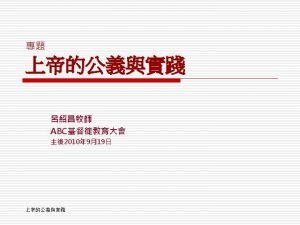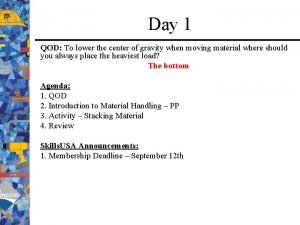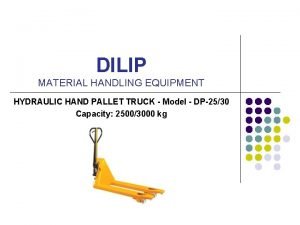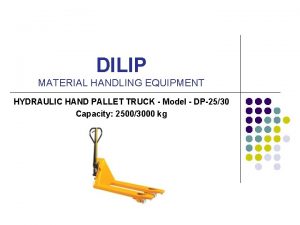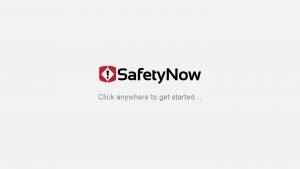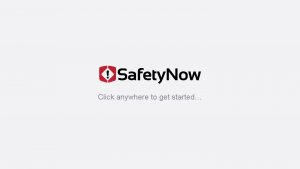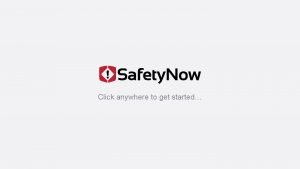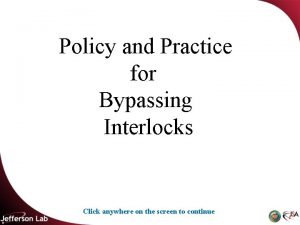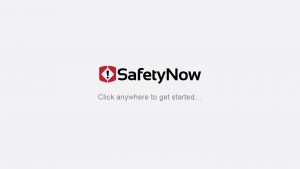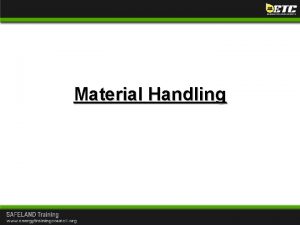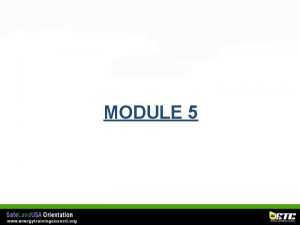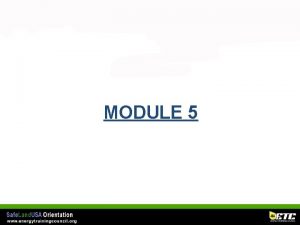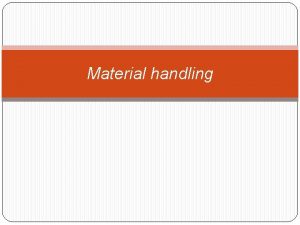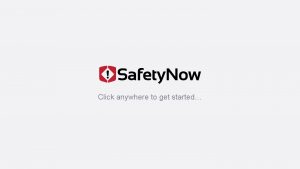Click anywhere to get started Material Handling Equipment












- Slides: 12

Click anywhere to get started…

Material Handling Equipment / Heavy Equipment

What’s at Stake? Heavy equipment includes cranes, maintainers, bull dozers, front loaders, dump trucks, excavators. These are used in virtually all construction sites. This equipment is effective but also hazardous. Proper work planning and operating equipment limited to its use, are essential steps for safe operation.

What’s the Danger? The two major hazards / dangers that are responsible for the majority of injuries and fatalities are: Struck-by incidents • One of the biggest exposures for a fatality on a construction site is ground personnel being struck by moving equipment. OSHA states approximately 75% of struck-by fatalities involve heavy equipment such as trucks or cranes. • Work areas where heavy equipment is should be clearly marked and barricaded. • Ground personnel entering a work area where there is equipment operating need to make their presence known to all operators in the area. • Operators should avoid backing whenever possible and need to stop their work task if they lose sight of any ground personnel. • A spotter should be used if equipment is operating in a tight area or when operating around ground personnel. • Plan work tasks accordingly and eliminate the need for a spotter if possible.

What’s the Danger? Caught-in or between incidents • A caught-in or between incident is when there is an injury due to crushing between two objects. • An excavator bucket swinging around and striking a person in an open field would be a struck-by incident. • One important safeguard in protecting yourself from these incidents is to stay out of the line of fire and always leave yourself an “out”. • Never put yourself in a situation where you do not have an out to escape danger. • It is important to always be able to get out of the way if other safeguards fail and you are put in a situation where you can become of victim of these incidents.

What’s the Danger? Other Hazards / Dangers • Slips, trips, and falls result in injuries to workers. Operators of heavy equipment are not exempt. Climbing into the cab of equipment or walking on the slick surfaces of a machine are two common occurrences. • Pinch points like door jams or equipment hoods are two common pinch point locations. • A loss in control results from an operator being distracted from their work due to objects moving around in their cab. • A leak in a pressurized line is especially hazardous. Hydraulic lines that are leaking can inject fluid underneath the skin of a worker. This kills tissue which often results in amputation of the affected body part if not treated quickly.

What’s the Danger? Other sources of injury: • Repairing and servicing equipment in dangerous positions. • Striking individuals or other vehicles with the equipment, particularly its blade. • Unexpected violent tipping of the equipment. • Uncontrolled traffic within or through the work area. • Unexpected violent shocks or jars to the machine. • Sudden movement of a power unit while it is being attached to earth moving equipment. • Limbs of trees or overhead obstructions • Leaving earth moving or other equipment in dangerous positions while unattended. • Failure of lifting mechanisms.

How to Protect Yourself It is obvious that there are many hazards and dangers in the use and operation of heavy equipment. Wellcoordinated “operating maintenance procedures” can ensure, as best, as possible, the safety of those working with and around heavy equipment. Here are ways to eliminate / reduce and mitigate against the hazards and dangers: • Always use three points of contact when climbing into the cab of heavy equipment. • Clear boots and steps of any mud to avoid slick conditions. • Watch hand placement and avoid pinch point areas. • Maintain a clean cab. Ensure any items within the cab are tied down. • Always complete a pre-use inspection prior to using heavy equipment.

How to Protect Yourself • • Never check for leaks on pressurized lines with your hands, even while wearing gloves. All equipment should be inspected prior to use. Equipment should have seatbelts and a roll over protective system. Work areas should be properly delineated and enough space given to heavy equipment to operate properly. • Operators should complete a walk around of their equipment every time before getting back into the cab to be sure no objects, people, or vehicles are in a blind spot. • Employees need to know the equipment they operate and ensure that they do not operate equipment if they are fatigued or sick.

How to Protect Yourself General Operating Precautions § Machines should be maintained in good working order. All vital parts of machines should be thoroughly inspected each day. § Before using the starting motor, the operator should check to make sure that all operating controls are in the neutral position. § Machines should be operated at speeds and in a manner consistent with conditions on the particular job. § Before starting a job, the operator must be given instructions regarding the work to be done. § At no time should a piece of equipment be left unattended while the motor is running.

How to Protect Yourself § If possible, equipment should be driven entirely off the road at night. § Operators should stop motors and refrain from smoking during refueling operations. § The operator should keep deck plates or steps on equipment free from grease, oil, ice and mud. Employees, other than operator, should not ride on equipment. § Operators should not wear loose clothing, which can get caught in moving parts of equipment.

Final Word There are many hazards that are present when dealing with heavy equipment on the work site. Consider what unique hazards / dangers the equipment and job tasks create in your work site. Constant focus on pre – planning as well as what safeguards are needed is important to remain safe while operating heavy equipment.
 Get in get on get off get out
Get in get on get off get out Injustice anywhere is a threat to justice anywhere
Injustice anywhere is a threat to justice anywhere Metaphasepdm
Metaphasepdm Tines
Tines Dilip material handling equipment
Dilip material handling equipment Dilip material handling equipment
Dilip material handling equipment Click anywhere to start
Click anywhere to start How is a struck-by rolling object defined?
How is a struck-by rolling object defined? Click anywhere to start
Click anywhere to start Click anywhere to start
Click anywhere to start Practice click
Practice click Click anywhere to start
Click anywhere to start One direction shot me out of the sky
One direction shot me out of the sky

